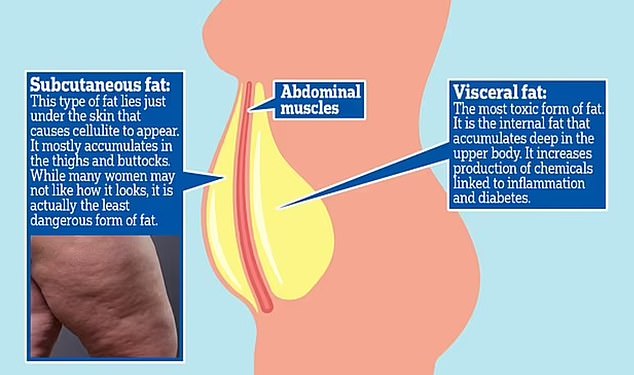People who have exercised for years, even those who remain obese, store body fat in a healthier way than their inactive counterparts.
Researchers at the University of Michigan took two groups of obese adults: one group that exercised at least four times a week for two years and another that did not exercise regularly.
Samples of fatty tissue from under the skin of people in both groups showed that those who exercised had more blood vessels in that tissue, meaning they had better oxygen flow throughout their bodies. Those who exercised also had better overall health indicators despite having the same amount of fat as those who did not exercise.
While the results may make it seem like people can exercise to compensate for a poor diet, the researchers only looked at subcutaneous fat — the fat that lies just under the skin.
This is different from visceral fat, a more dangerous type that builds up around vital organs, causing inflammation, high blood pressure, heart disease and, in some cases, nonalcoholic fatty liver disease.
The two groups of people had similar fat masses, but the group that exercised regularly for years experienced better heart health and better insulin regulation, which led to better overall health.
Dr. Jeffrey Hotowitz, an exercise scientist at the University of Michigan, said: “Our findings indicate that in addition to being a means of expending calories, exercising regularly over several months or years appears to modify fat tissue in ways that allow you to store your body fat more healthily if you experience some weight gain, as almost everyone does as we age.”
Dr. Horowitz added: “We generally see that these differences are stronger in people who exercise regularly for years compared to those who don’t.”
Their research was published in the journal Nature’s metabolism.
Researchers found through blood tests, MRIs and samples of fat tissue examined in the lab that, despite having the same body fat mass and weight, those who exercised regularly had better heart health.
Their bodies were also more effective at regulating insulin levels, potentially preventing obesity-linked diabetes.
Blood tests revealed that those who exercised regularly tended to have higher levels of “good” HDL cholesterol.
Blood tests also showed that those who exercised frequently had fewer markers of inflammation in the body and better liver function than their sedentary counterparts.
Regular exercise has also been found to reduce the size of fat cells and increase their ability to store and release energy. It also reduces the amount of visceral fat a person has, which lowers the risks of a host of chronic health problems.
The study subjects had subcutaneous fat, according to the researchers, who did not look at the more dangerous visceral fat.

The researchers specifically studied subcutaneous fat in 32 people: 16 who exercised four times a week for an average of 11 years and 16 people who led sedentary lives.
This is not to say that subcutaneous fat is not dangerous. Excess fat can lead to serious health problems, including diabetes, heart disease, high blood pressure, joint pain, sleep apnea, and fatty liver disease.
Excess abdominal fat can also cause fatty tissue to become denser, which disrupts the normal functioning of fat in the body. Fat stores energy for later use, produces hormones, and regulates metabolism.
People who exercised frequently also had less of a type of collagen that is closely associated with metabolism-related problems, including type 2 diabetes, obesity, an abnormally high amount of fat in the blood, an overactive thyroid gland and nonalcoholic fatty liver disease.
In people with obesity, the size of fat cells also affects the number of blood vessels in fatty tissue that carry oxygen to tissues in other parts of the body.
Large fat cells often result in fewer blood vessels in the fatty tissue, which can reduce the oxygen supply to the fat, cause inflammation and possible scarring.
Although fat cells in both groups were similar in size, those who exercised had more blood vessels in their fat tissue, suggesting that regular exercise improves the ability of fat tissue to receive oxygen and nutrients.
This is not the first study to show that exercise can increase blood vessel growth, but scientists have not yet reached a consensus on how many weeks or months of exercise it takes to see a noticeable increase in blood vessels in fatty tissue in overweight or obese people.
The UM study offers valuable information, though it may be discouraging for obese people who are just beginning their fitness journey and want faster results.


